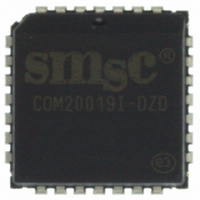COM20019I-DZD SMSC, COM20019I-DZD Datasheet - Page 20

COM20019I-DZD
Manufacturer Part Number
COM20019I-DZD
Description
IC CTRLR ARCNET 2KX8 RAM 28-PLCC
Manufacturer
SMSC
Series
ARCNETr
Datasheet
1.COM20019I-DZD.pdf
(65 pages)
Specifications of COM20019I-DZD
Controller Type
ARCNET Controller
Interface
Differential
Voltage - Supply
4.5 V ~ 5.5 V
Current - Supply
20mA
Operating Temperature
0°C ~ 70°C
Mounting Type
Surface Mount
Package / Case
28-PLCC
Lead Free Status / RoHS Status
Lead free / RoHS Compliant
Other names
638-1000-5
Available stocks
Company
Part Number
Manufacturer
Quantity
Price
Company:
Part Number:
COM20019I-DZD
Manufacturer:
SMSC
Quantity:
1 028
Company:
Part Number:
COM20019I-DZD
Manufacturer:
Microchip Technology
Quantity:
10 000
Company:
Part Number:
COM20019I-DZD-TR
Manufacturer:
Microchip Technology
Quantity:
10 000
5.2.2
5.2.3
Rev. 09-25-07
In typical applications, the serial backplane is terminated at both ends and a bias is provided by the
external pull-up resistor.
The RXIN signal is directly connected to the cable via an internal Schmitt trigger. A negative pulse on this
input indicates a logic "1". Lack of pulse indicates a logic "0". For typical single-ended backplane
applications, RXIN is connected to nPULSE1 to make the serial backplane data line. A ground line (from
the coax or twisted pair) should run in parallel with the signal. For applications requiring different treatment
of the receive signal (like filtering or squelching), nPULSE1 and RXIN remain as independent pins.
External differential drivers/receivers for increased range and common mode noise rejection, for example,
would require the signals to be independent of one another. When the device is in Backplane Mode, the
clock provided by the nPULSE2 signal may be used for encoding the data into a different encoding
scheme or other synchronous operations needed on the serial data stream.
Differential Driver Configuration
The Differential Driver Configuration is a special case of the Backplane Mode.
configuration recommended for applications like car-area networks or other cost-sensitive applications
which do not require direct compatibility with existing ARCNET nodes and do not require isolation.
The Differential Driver Configuration cannot communicate directly with nodes utilizing the Traditional
Hybrid Configuration. Like the Backplane Configuration, the Differential Driver Configuration does not
isolate the node from the media.
The Differential Driver interface includes a RS485 Driver/Receiver to transfer the data between the cable
and the COM20019I. The nPULSE1 signal transmits the data, provided the Transmit Enable signal is
active. The nPULSE1 signal issues a 1.6µS negative pulse to transmit a logic "1". Lack of pulse indicates
a logic "0". The RXIN signal receives the data, the transmitter portion of the COM20019I is disabled
during reset and the nPULSE1, nPULSE2 and nTXEN pins are inactive.
Programmable TXEN Polarity
To accommodate transceivers with active high ENABLE pins, the COM20019I contains a programmable
TXEN output. To program the TXEN pin for an active high pulse, the nPULSE2 pin should be connected
to ground. To retain the normal active low polarity, nPULSE2 should be left open.
determination is made at power on reset and is valid only for Backplane Mode operation. The nPULSE2
pin should remain grounded at all times if an active high polarity is desired.
75176B or
Equiv.
RT
Figure 5.4 - COM20019I NETWORK USING RS-485 DIFFERENTIAL TRANSCEIVERS
COM20019I
DATASHEET
RBIAS
+VCC
COM20019I
Page 20
Cost Competitive ARCNET (ANSI 878.1) Controller with 2K x 8 On-Chip RAM
+VCC
RBIAS
COM20019I
+VCC
It is a dc coupled
RBIAS
SMSC COM20019I
The polarity
RT













